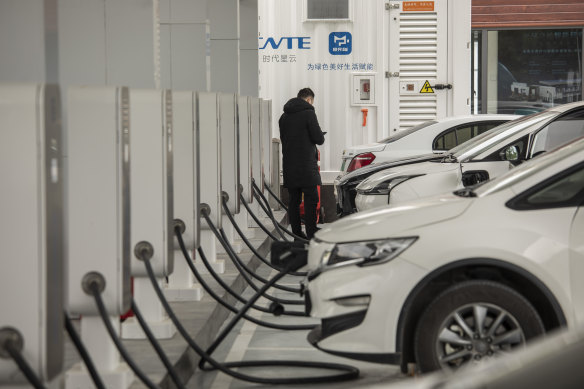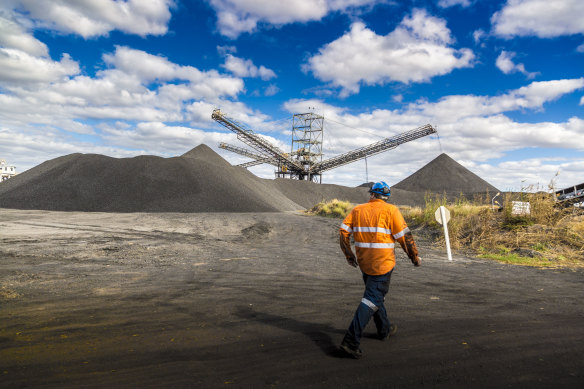This was published 7 months ago
Opinion
Green dreams go bad: Why feel-good investing doesn’t make for good returns
William Bennett
Money contributorIt’s not easy being green in 2024 – just ask investors who bought into the hype around the “green energy revolution” years ago and are now nursing hefty losses.
In the past month, shares in “green” sectors such as lithium, uranium, hydrogen, and solar have hit yearly, or multi-year lows, despite broader stock markets hitting record highs.

Lithium, a key component of batteries for electric vehicles, has been falling in price.Credit: The New York Times
The price of the most-hyped green commodity, lithium, continues to capitulate, last week hitting five-year lows as sluggish demand from battery makers fails to match a global oversupply.
This month, Pilbara Minerals – Australia’s largest lithium stock and also the most shorted stock on the ASX – also hit new multi-year lows in solidarity with the broader lithium price. Industry forecasters are warning the supply-demand balance might not correct until the end of the decade.
It’s a harsh lesson in investing based on a feel-good “make money and save the world” narrative, instead of investing using fundamental or technical analysis.
“Rational decision goes out the door when in love with a thesis,” says Travis Ricciardo, host of the popular mining industry podcast Money of Mine, which has been covering the lithium rout.
Despite the utopian rhetoric around green energy, the supply of these commodities still overwhelms demand.
“It never made sense to me why these (lithium) companies traded at such a premium just because they were considered green, when their cash flows didn’t support the valuation,” says Ricciardo.
The other (glowing) green sector, uranium, has also been in meltdown despite starting the year strongly. Our three largest listed uranium stocks – Paladin, Boss Energy and Deep Yellow – have fallen 45 per cent or more from their May peaks and are now negative for the year.
Rounding out the trilogy is green hydrogen, the supposed oil and coal killer, which has been about as successful as an investing in shares of the Zeppelin Company (maker of the hydrogen-powered Hindenburg).
Even our ever-optimistic green hydrogen evangelist Andrew “Twiggy” Forrest has been forced to check his ambitions, as spending shareholder cash on green hydrogen dreams also proves bad for the investor relations environment.
“I think we’re more likely to see a perpetual motion machine built before green hydrogen lives up to its hype,” says Ricciardo.
Global exchange-traded funds (ETFs) that track baskets of companies in lithium, hydrogen and solar sectors are all down more than 25 per this year whilst the global uranium ETF is off a more modest 3 per cent. Still, ETFs of the S&P500 are up 20 per cent, and Nvidia, a stock with a good story and has a commodity – semiconductors – in high demand, is up 160 per cent.
It’s a worldwide theme: despite the utopian rhetoric around green energy, the supply of these commodities still overwhelms demand. Ironically, the “dirty” commodity, old king coal, reigns supreme with global demand continuing to climb, unlike lithium, uranium and hydrogen.
That’s quite the counter-narrative.

Ironically, coal investments have been performing strongly.Credit: Glenn Hunt
“It’s important for investors to recognise that green investment themes are not necessarily correlated, and hence it’s important to select exposures carefully,” says Emanuel Datt, managing director at Datt Capital, a Melbourne-based fund that has made good returns investing in niche green commodities.
“We expect green commodities with truly constrained supply scarcity such as niobium and tin to outperform relative to more abundant green commodities such as lithium and nickel.”
It might be one of those lessons that investors can only learn the hard way. I know I’m not the only one to have a few “legacy” lithium shares in the bottom drawer that haunt me every day.
“Whilst mistakes are unavoidable, holding on to mistakes can detract from recognising great investment opportunities that may present themselves. Every loss taken represents an opportunity to improve one’s investing into the future,” reminds Datt.
“Medium-term, it’s looking grim for lithium stocks,” adds Ricciardo. “Supply curtailment usually marks the bottom of commodity cycles, but lithium production has continued to increase.”
Some in the industry remain hopeful that lithium prices are close to nearing a cyclical bottom, with telltale signs of a cycle reversing with mine closures, mergers, and acquisitions spreading across the sector.
There will be a time when green commodity stocks make for good investments; the mere publication of this article means that time will likely be soon – we in the media are good contrarian indicators.
However, the lessons on the dangers of “falling in love” with an investment narrative remain, because love can blind you, including from a falling share price.
Will Bennett is a freelance business journalist and day trader.
- Advice given in this article is general in nature and is not intended to influence readers’ decisions about investing or financial products. They should always seek their own professional advice that takes into account their own personal circumstances before making any financial decisions.
Expert tips on how to save, invest and make the most of your money delivered to your inbox every Sunday. Sign up for our Real Money newsletter.